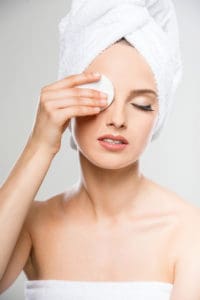Guide to Meibomian Gland Dysfunction (& Treatment)
Home / Eye Conditions & Eye Diseases /
Last Updated:
Meibomian gland dysfunction (MGD) is an eye condition that is very common. It is estimated that about 86 percent of people who experience dry eyes also have MGD. It can result in eye dryness and irritation.
Table of Contents
In the eyelids are glands, including the meibomian glands. When an abnormality or blockage affects the glands, it is referred to as meibomian gland dysfunction.
There is the Meibomian Gland Evaluator that doctors can use to determine if someone has this condition. The doctor might also test a person’s tears to get more information about the health of these glands.
Older standards of treatment, such as warm compresses, are not effective on their own. Because of this, doctors have started using newer treatment options that are more effective, such as meibomian gland probing and different types of eye drops.

MGD Basics
On the lower eyelids, people have 20 to 25 of these glands, and on the upper eyelids, they have 40 to 50 of these glands.
They are a type of sebaceous gland that secretes meibum or oil. This is secreted every time a person blinks, and it then spreads across the eye’s surface. This works to ensure proper lubrication of the eyes.
You deserve clear vision. We can help.
With 135+ locations and over 2.5 million procedures performed, our board-certified eye surgeons deliver results you can trust.
Your journey to better vision starts here.
When someone has this condition, inflammation can develop in the glands. The secreted oil’s chemical makeup can change over time, causing it to become overly thick. For some people, they will have too much of the oil.
The tear film that coats the eyes can become unstable. This can cause inflammation with the eye’s surface.
When this condition is chronic, impaction or blockage can occur. It is also possible to develop an infection referred to as a stye.
A stye develops at the eyelash edges. It results from a bacterial infection and can cause pain, sensitivity, and swelling.
MGD Symptoms

Once symptoms start, they may include the following:
- Burning
- Stickiness or crustiness
- Light sensitivity
- Foreign body sensation
- Intermittent blurry vision
- Dryness
- Itching
- Watering
- Eye redness
- Styes
Diagnosing Meibomian Gland Dysfunction
Before doctors can provide treatment, they need to ensure that the person’s symptoms are due to MGD. There are certain diagnostic tests that can help doctors to provide a definitive diagnosis.
The Meibomian Gland Evaluator allows doctors to test the function of the meibomian glands. They use a slit lamp to look at the secretions while inducing a deliberate blink. This test can also be used to determine a person’s response to treatment and the severity of their MGD.
There is also a test that focuses on the person’s tear film since this condition affects tear film stability. One common test is referred to as the tear breakup time test. This test is painless and simple.
The doctor puts dye onto the person’s tear film. They use a cobalt blue light to examine the eye. This allows them to see how fast the tear film’s stability is lost.
Treatment Options for MGD

There are several treatment options that doctors might recommend. For some people, one treatment is enough, but others might need a complete regimen to alleviate their symptoms.
- Lid hygiene: This is a common first step in treating this condition. People will apply a warm compress once a day to help clear the glands.
- Scrub: Following the compress, there is usually a special scrub they will use. These are typically available over the counter. However, newer solutions, such as the biochemical hypochlorous acid, are showing to be more beneficial than older surfactant eye scrubs.
- Lid warming: One study looked at the efficacy of lid warming using a hot compress and two commercial systems, including the Blephasteam and EyeGiene. Over the course of 12 weeks, the researchers measured tear evaporation rates. After analyzing 30 distinct lipids, they concluded that this treatment and its effect on increasing lipids allowed for slowed evaporation and greater integrity for the tear lipid layer.
- Massage: When applying the warm compress, some doctors will recommend gently massaging the lid margin. This is the area located right above the eyelashes. It is important to be gentle since irritation can occur if someone uses too much pressure while performing the massage.
- Supplements: Omega-3 fatty acid supplements might be recommended. Supplementation with this nutrient has been shown to improve meibomian gland oil consistency and quality. Other nutrient supplements that may be beneficial include flaxseed oil and fish oil. The doctor can recommend a quality brand and the proper daily dose.
- Steroids: Doctors may prescribe a topical steroid that is applied directly to the eyes. This can reduce inflammation and ease symptoms. It can also be used by physicians to ensure that they make an accurate diagnosis of MGD. Initially, the topical steroids are prescribed for two to four weeks.
- Tetracycline: Derivatives or tetracycline itself may provide a dual therapeutic effect for this condition. They work to reduce bacteria in the glands. This effect may also aid in alleviating inflammation affecting the glands. In some cases, doctors will prescribe these medicines for up to several months, depending on how the person is responding to treatment.
- Antibiotics: There are also topical antibiotics doctors might consider. These include the topical gel form of azithromycin. The duration of treatment may last from 10 to 30 days, depending on how the person is responding to the medications.
- Meibomian gland probing: A doctor will perform the probing, and it is a relatively simple procedure. The purpose is the open the main meibomian gland duct. The doctor applies eye drops that have an anesthetic effect to promote comfort. Using a handheld device, the doctor dilates the gland openings located at the eyelash base. This may encourage oil secretion or alleviate an obstruction.
- Cyclosporine eye drops: This medicine works by modifying the immune response in the body. Medications, such as Restasis, may help to reduce dry eye by working on the immune response.
- LipiFlow: This is a device a doctor can use in their office. It is a type of thermal pulsation system that may melt waxy deposits in the gland using heat. The pulsing pressure that occurs along with the heat helps to open the glands, so anything in them can be expressed.
Each LipiFlow session takes about 12 minutes. The eyes do not experience any of the pressure or heat, so the procedure is relatively comfortable. The research shows that this treatment can help to significantly decrease MGD symptoms.
- Punctal plugs: LipiFlow may be used along with punctal plugs. These plugs might also be used on their own in some cases. The plugs go into the tear ducts to prevent tears from draining out. This ensures greater surface and tear film moisture for the eyes.
When eye drops are not adequately alleviating eye dryness, these plugs might be considered. The doctor may insert a dissolvable plug to see if these plugs could be beneficial over the long term. If they show promise, semi-permanent plugs might be inserted.
Possible Complications of MGD
When MGD is left untreated, there is the potential for complications. The evaporative dry eye that occurs with this condition puts people at risk for desiccation of the cornea. This means that all the moisture is out of the cornea, causing it to dry out. Scar tissue can form once this condition gets to this point.
There is also the risk for atrophy of the glands. Once this happens, little can be done to make the meibomian glands function in a normal way again.
Due to the discomfort this condition can cause, if someone suspects they may have it, they should reach out to their eye doctor. There are treatment options that can alleviate the symptoms and help people to be more comfortable.

You deserve clear vision. We can help.
With 135+ locations and over 2.5 million procedures performed, our board-certified eye surgeons deliver results you can trust.
Your journey to better vision starts here.
References
- Distribution of Aqueous-Deficient and Evaporative Dry Eye in Clinic-Based Patient Cohort: A Retrospective Study. (May 2012). Cornea.
- Meibomian Gland Dysfunction Symptoms and Treatment. (January 22, 2019). Verywell Health.
- Sty (Stye). Cleveland Clinic.
- Meibomian Gland Dysfunction and Treatment. American Association for Pediatric Ophthalmology and Strabismus.
- Meibomian Gland Evaluator. TearScience.
- Tear Breakup Time (TBUT). University of Iowa Health Care.
- How Effective Is Lid Warming for Meibomian Gland Dysfunction? (January 2015). EyeWorld.
- Tools of the Trade: Current Techniques to Treat Meibomian Gland Dysfunction. (May 15, 2016). Review of Optometry.
- Meibomian Gland Probing: The Who, What, Where, When, and Why. (October 2017). EyeWorld.
- What to Expect from Your Dry Eye Device. (October 5, 2015). Review of Ophthalmology.
- Punctal Plugs for Dry Eyes. All About Vision.
This content is for informational purposes only. It may have been reviewed by a licensed physician, but is not intended to serve as a substitute for professional medical advice. Always consult your healthcare provider with any health concerns. For more, read our Privacy Policy and Editorial Policy.
